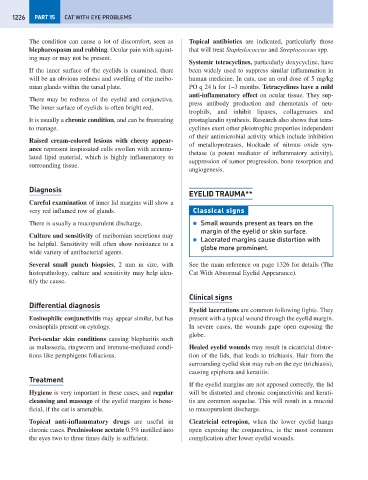Page 1234 - Problem-Based Feline Medicine
P. 1234
1226 PART 15 CAT WITH EYE PROBLEMS
The condition can cause a lot of discomfort, seen as Topical antibiotics are indicated, particularly those
blepharospasm and rubbing. Ocular pain with squint- that will treat Staphylococcus and Streptococcus spp.
ing may or may not be present.
Systemic tetracyclines, particularly doxycycline, have
If the inner surface of the eyelids is examined, there been widely used to suppress similar inflammation in
will be an obvious redness and swelling of the meibo- human medicine. In cats, use an oral dose of 5 mg/kg
mian glands within the tarsal plate. PO q 24 h for 1–3 months. Tetracyclines have a mild
anti-inflammatory effect on ocular tissue. They sup-
There may be redness of the eyelid and conjunctiva.
press antibody production and chemotaxis of neu-
The inner surface of eyelids is often bright red.
trophils, and inhibit lipases, collagenases and
It is usually a chronic condition, and can be frustrating prostaglandin synthesis. Research also shows that tetra-
to manage. cyclines exert other pleiotrophic properties independent
of their antimicrobial activity which include inhibition
Raised cream-colored lesions with cheesy appear-
of metalloproteases, blockade of nitrous oxide syn-
ance represent inspissated cells swollen with accumu-
thetase (a potent mediator of inflammatory activity),
lated lipid material, which is highly inflammatory to
suppression of tumor progression, bone resorption and
surrounding tissue.
angiogenesis.
Diagnosis
EYELID TRAUMA**
Careful examination of inner lid margins will show a
very red inflamed row of glands. Classical signs
There is usually a mucopurulent discharge. ● Small wounds present as tears on the
margin of the eyelid or skin surface.
Culture and sensitivity of meibomian secretions may
● Lacerated margins cause distortion with
be helpful. Sensitivity will often show resistance to a
globe more prominent.
wide variety of antibacterial agents.
Several small punch biopsies, 2 mm in size, with See the main reference on page 1326 for details (The
histopathology, culture and sensitivity may help iden- Cat With Abnormal Eyelid Appearance).
tify the cause.
Clinical signs
Differential diagnosis
Eyelid lacerations are common following fights. They
Eosinophilic conjunctivitis may appear similar, but has present with a typical wound through the eyelid margin.
eosinophils present on cytology. In severe cases, the wounds gape open exposing the
globe.
Peri-ocular skin conditions causing blepharitis such
as malassezia, ringworm and immune-mediated condi- Healed eyelid wounds may result in cicatricial distor-
tions like pemphigeus foliacious. tion of the lids, that leads to trichiasis. Hair from the
surrounding eyelid skin may rub on the eye (trichiasis),
causing epiphora and keratitis.
Treatment
If the eyelid margins are not apposed correctly, the lid
Hygiene is very important in these cases, and regular will be distorted and chronic conjunctivitis and kerati-
cleansing and massage of the eyelid margins is bene- tis are common sequelae. This will result in a mucoid
ficial, if the cat is amenable. to mucopurulent discharge.
Topical anti-inflammatory drugs are useful in Cicatricial ectropion, when the lower eyelid hangs
chronic cases. Prednisolone acetate 0.5% instilled into open exposing the conjunctiva, is the most common
the eyes two to three times daily is sufficient. complication after lower eyelid wounds.

